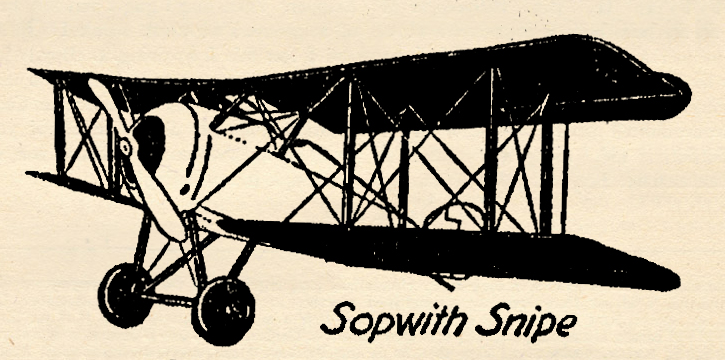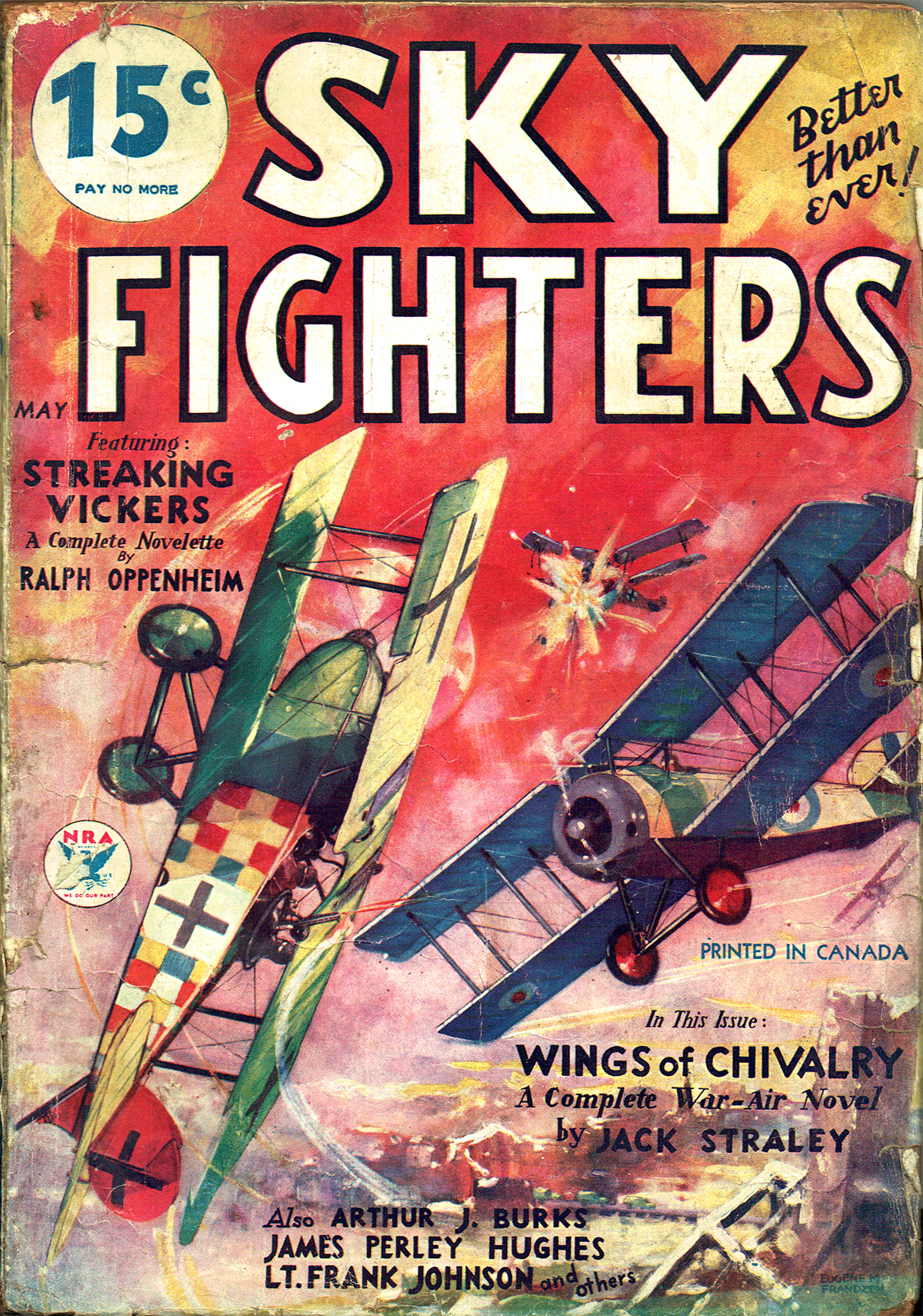Eugene M. Frandzen painted the covers of Sky Fighters from its first issue in 1932 until he moved on from the pulps in 1939. At this point in the run, the covers were about the planes featured on the cover more than the story depicted. On the May 1934 cover, Frandzen featured the Sopwith Snipe and the Halberstadt C-4!
ON THIS month’s cover  the two types of ships shown are the Sopwith Snipe and the Halberstadt C-4.
the two types of ships shown are the Sopwith Snipe and the Halberstadt C-4.
The Sopwith Snipe was considered by many to be the finest job turned out by the Sopwith Company. The 1918 Snipe knocked the Germans out of the skies with system and precision. In four days a single Snipe squadron accounted for thirty-six enemy planes. In one day alone they smacked down thirteen.
Major Barker, of Canada, pulled the outstanding feat of his career in a Snipe. Attacked by fifty Boche planes he fought back, downed four and lived to tell the tale. He gave lots of credit to his Snipe.

The Halberstadt C-4 was a good all round fighter-reconnaissance plane. Its bulky forward fuselage and its thin, tapering short section behind the cockpits gave it a nose-heavy appearance. Despite its awkward proportions it had good flying characteristics and was a dependable ship when not forced beyond the limits of its class.
One of the pastimes indulged in by the retreating Germans during 1918 was blowing up bridges they had crossed. And one of the best little things our hard-worked engineers did was to smack down pontoon bridges to replace them.
Of course then the Boche artillerymen came out of their dugouts and popped over a few tons of steel-cased shells, which, if nicely directed had the nasty habit of destroying the engineers floating road. Now the obszrvers in the two-seaters had to direct this demolition fire by wireless. They were usually protected by several scout plinos flying above and capable of giving even battle to anyone asking for an argument.
A little mix-up of this sort is happening in the picture on the cover. The Halberstadt has spotted the pontoon bridge. He gets his wireless going. The German artillerymen start ranging their shells. Above are his protecting planes, Fokkers. Hardly had the German observer warmed up his dot-dash key than two Sopwith Snipes swooped down on the Fokkers, sent two of them down. One Fokker remained. One Snipe started after him while the other Snipe tore in at the Halberstadt.
The German reeled in his aerial and un-limbered his Parabellum gun. He signalled his pilot to fight his way out. Above he saw the lone Fokker coming down to his assistance.

The Snipe roared in on the two-seater, guns blazing. The Halberstadt pilot flipped his ship up and over. His gunner all set for this maneuver pressed his trigger as the plane started up. He kept the gun chattering as the Halberstadt started over on its back. He hoped to catch the Snipe in his spraying arc of fire.
Twin Vickers bucking in their mounts on the Snipe; the Parabellum vibrating in the hands of the German observer. Three streams of lead slicing through the air, perforating fabric, ricocheting off metal parts.
The diving Fokker abruptly disintegrates in mid-air. A ranging German Shell hunting the pontoon bridge hits his ship, explodes; blows the ship to bits.
The odds are now too great for any two-seater, no matter how good it, or its crew, may be. A matter of minutes remain till it will be all over. Trucks, cannon and infantry will continue to pass over the pontoon bridge, shelled of course, but not as accurately as would have been the case had the artillery-directing Halberstadt been allowed to remain on tha job five minutes longer.

Sky Fighters (Canadian Edition), May 1934 by Eugene M. Frandzen
(The Ships on The Cover Page)
Next time, Mr. Frandzen features the German Junkers and D.H.4!
 Like many in the late 20’s and early 30’s, Robert O’Neil was fascinated with aviation and as such, a large part of both volumes of his scrapbooks is taken up with a cataloging of the many different types of planes.
Like many in the late 20’s and early 30’s, Robert O’Neil was fascinated with aviation and as such, a large part of both volumes of his scrapbooks is taken up with a cataloging of the many different types of planes. 

















